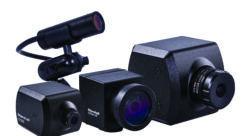
POV: Thinking Small
Oct 7, 2009 12:00 PM,
Provided by InfoComm International
Ever since pico projectors hit the retail market in mid-2008, awareness has grown about the promise of these tiny handheld, pocket-sized devices. The interest in pico (pronounced “pee-co”) projectors reflects the world’s increasingly mobile workforce and the desire to share content with anyone at any time. However, first-generation picos didn’t quite live up to the hype.
“Performance was marginal; they had low lumen output (in the 7 ANSI lumen range) and less than VGA resolution. They were expensive relative to performance with price tags of $350 or more, but it did fit in your pocket,” says Matthew S. Brennesholtz of Insight Media, a research firm that focuses on emerging display technologies. He is also the author of the 2009 Insight Media Pico Projector Report.
Brennesholtz notes that the current generation of pico projectors has better performance and price than previous picos. “Manufacturers are beginning to add more features. Most have built-in media players, and light output is improving to 10 to 12 ANSI lumens,” he adds. “Now, there is a pico projector with Windows CE built into it that will accept an external keyboard and mouse.”
AV pros may scoff at 12 ANSI lumens as improved performance, but with pico projectors, as with any emerging technology, the focus is on the potential of future technology improvements. “They produce a relatively large image from a small device. On an iPhone or iPod Touch, you are limited to a small 2in. or 3in. screen, but if you have a pico, you can project a 20in. to 30in. image,” Brennesholtz explains.
Gabe Wiebenga, marketing and product manager for 3M’s MPro line of pico projectors, says that picos are part of the drive to a single-use device. The company recently launched its second generation of picos that offer better color saturation and light output than the previous generation, a 4-hour battery, and integrated loudspeakers. “Because they are handheld, they are designed to a more rugged standard than a traditional tabletop projector. LEDs generate less heat and have a longer lifespan than traditional bulb-based projectors,” he adds.
According to Insight Media’s pico projectors end-user survey, the majority of respondents were middle-aged men who purchased the projector for both entertainment and professional applications.
Perhaps the biggest impact that picos will have on professional AV is in the digital signage market. Chris Riegel, CEO of Stratacache, a digital signage solutions company, takes a very bullish stance. “Picos will decimate traditional LCD digital signage in the next few years. Picos offer much less cost, need less power, and have a longer lifespan than LCDs in most environments,” he says.
Stratacache has worked on developing pico optical engines with Texas Instruments (TI) for the past two years. TI manufactures the DLP pico chip set, the competing technology to 3M’s LCoS chip set.
Riegel also adds that, due to reliability and maintenance issues, projectors have always been a four-letter word to digital signage installers. “However, picos have the same reliability as IT network devices but not the same faults and limitations as traditional projectors,” he says.
Pico projectors can be used in both traditional and nontraditional means of digital signage. They can save space in more traditional “point of presence” messaging like an 8.5”x11” advert at a bank teller window or the day’s specials projected into a restaurant tabletop. But because LEDs are less temperature sensitive than bulb-based projectors, pico projectors can also be installed in a grocery store’s beer cooler for rear projection onto the cooler door.
“We’ve built a pico optical engine into our media player and added a 3G wireless connection for content updates, so we can put a pico literally anywhere as long as there is a power outlet,” Riegel says.
Pico projectors are not poised to overtake or replace traditional bulb-based projection systems any time soon. But as the technology advances, pico projectors will be hard to ignore. “People see picos built into cell phones like cameras are built into them now. It is an optimistic forecast for 1 to 2 billion sold (one for every cell phone),” Brennesholtz says. “I think there will be hundreds of millions on the market by 2015.”
This is an excerpt from InfoComm International’s Special Report on Pico Projectors. To view to complete report visit www.infocomm.org.









